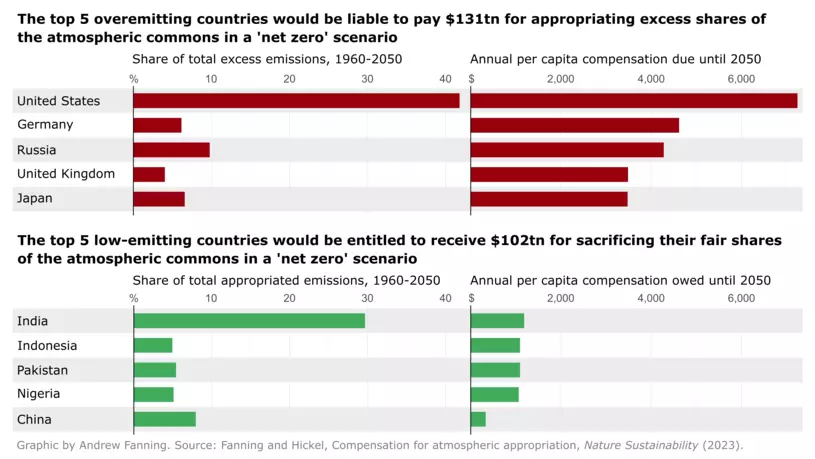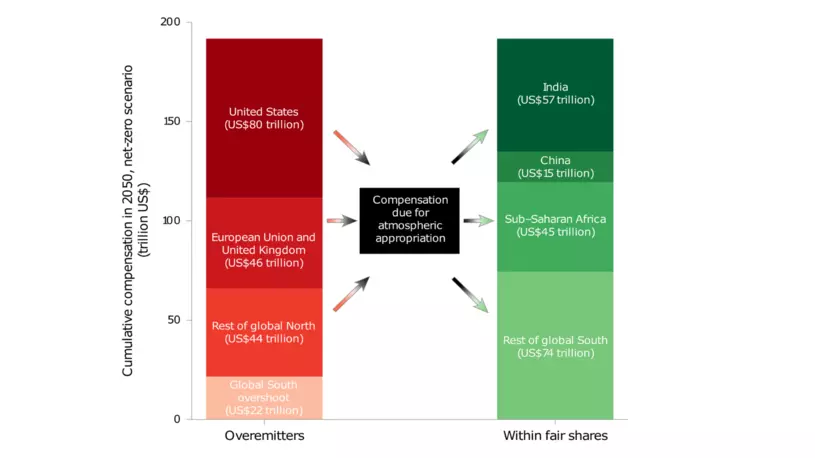
Study says global North owes $170 trillion for excessive CO2 emissions
Study argues a compensation scheme is needed to achieve climate targets and polluting countries should pay

“It is a matter of climate justice that if we are asking nations to rapidly decarbonise their economies, even though they hold no responsibility for the excess emissions that are destabilising the climate, then they should be compensated for this unfair burden.”
- Dr. Andrew Fanning, Research and Data Analysis Lead, DEAL
A study published today in the scientific journal Nature Sustainability, co-authored by the DEAL Team's Andrew Fanning with Jason Hickel, argues that industrialised nations responsible for excessive levels of carbon dioxide emissions could be liable to pay a total of $170 trillion in compensation or reparations by 2050 to ensure climate change targets are met.
In the paper entitled, 'Compensation for atmospheric appropriation', the international team of researchers reveal that the $170 trillion amount, which is nearly $6 trillion per year or about 7% of annual global Gross Domestic Product (GDP), would be distributed as compensation to low-emitting countries that must decarbonise their economies far more rapidly than would otherwise be required.
Financial redress for the losses and damages that climate-vulnerable countries face due to the excessive CO2 emissions of others is seen as an increasingly important part of international climate change negotiations. Delegates at the COP 27 talks in Egypt last year agreed to establish a Loss and Damage Fund for countries affected by climate change. It is the first scheme where countries historically responsible for excessive CO2 emissions are held liable to fund compensation.
Levels of compensation
According to the study, the UK could be liable to pay $7.7 trillion for excessive CO2 emissions over the period to 2050 – that is equivalent to an annual payment of nearly $3,500 per capita each year until 2050.
The US could be liable to pay $80 trillion over the period or an annual per capita payment of more than $7,200 until 2050.
India historically has been a low carbon emitter and could be entitled to receive compensation of $57 trillion, or nearly $1,200 per capita each year until 2050.
Evidence-based system for assessing losses

The compensation system is based on the idea that the atmosphere is a commons, a natural resource for everyone to use equitably and sustainably.
To set a monetary value on the losses incurred by low-carbon emitting countries, the researchers first obtained the most recent remaining global ‘carbon budgets’ estimated by the Intergovernmental Panel on Climate Change (IPCC).
The researchers then calculated an equality-based ‘fair share’ of that total carbon budget for 168 countries, based on population size. They compared each country’s fair share allocation against how much CO2 that country has released historically from 1960, together with an ambitious scenario where it decarbonises from current levels to ‘net zero’ by 2050.
Some countries were within their fair share allocation, while others, most notably the industrialised nations of the global North, have already significantly overshot their allocation - in effect, appropriating other countries’ fair shares of the atmospheric commons.
For example, the UK has used 2.5 times its fair share - and the US has used more than four times its fair share. India, on the other hand, has used just under one quarter of its fair share.
Pricing the losses faced by low-emitting countries
Using carbon prices from the latest IPCC scenarios, the researchers were able to put a monetary value on each country’s excess emissions in a world that respects the 1.5-degree climate target.
That total figure was $192 trillion (within a range of between $141 trillion and $298 trillion), with the global North responsible for 89%, or $170 trillion, and the remainder from high-emitting countries in the global South, especially the oil-producing states, such as Saudi Arabia and United Arab Emirates.

Under the scheme, that money would be divided among the low carbon-emitting countries based on how much of their fair share allocation they would lose.
The researchers have also developed an interactive website which allows people to explore which countries could be entitled to receive compensation and how much, and which countries could be liable to pay.
Have you read the study and checked out the interactive website and still want more? Keep watching this space, we'll be updating it and our socials of upcoming events exploring this important topic.
Read the study:
Fanning, A.L. and Hickel, J. (2023). Compensation for atmospheric appropriation. Nature Sustainability (in press). https://doi.org/10.1038/s41893-023-01130-8.
Explore the interactive webpage:
https://goodlife.leeds.ac.uk/atmospheric-appropriation/
Further information:
Study finds wealthy nations responsible for 74% of global ecological damage
Photo credit: Photo by Markus Spiske on Unsplash